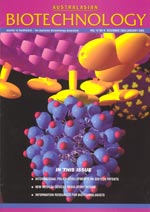
|
Australasian Biotechnology (backfiles)
AusBiotech
ISSN: 1036-7128
Vol. 8, Num. 1, 1998
|
Australasian Biotechnology,
Volume 8 Number 1, January/February 1998, pp. 21-22
SPECIAL FEATURE
Australian Developments in Biotechnology Regulation
Sue Meek
Code Number:AU98003
Sizes of Files:
Text: 7K
Graphics: No associated graphics files
Foreword
There is an increasing requirement to move Genetically Modified Organisms
(GMOs) out of the laboratory to evaluate their safety and efficacy in the
field and to obtain approvals for general (unrestricted) release and sale.
This trend is generating both environmental and commercial imperatives
for an efficient and effective regulatory system for biotechnology in Australia.
In addition, the implementation process for the Convention on Biodiversity,
which Australia became a signatory to in 1991, has prioritised the negotiation
of a Protocol on Biosafety to "regulate the safe transboundary movement
of Living Modified Organisms (LMOs)". This will create a legally-binding
agreement with the potential to impact significantly upon movement and
trade in GMOs and may in turn require countries to changes their regulatory
systems to comply with these international obligations.
The development and implementation of a nationally consistent system
of regulation for GMOs in Australia requires agreement and cooperation
between Commonwealth, State and Territory Governments and meaningful consultation
with a wide range of interest groups. Whilst negotiations on this issue
began at the end of the last decade, it is fair to say that some momentum
was lost in recent years. However, the pressures outlined above have stimulated
a number of separate but complementary initiatives, led to great effect
by a number of Commonwealth Agencies, which demonstrate that Australia's
excellent reputation internationally as an innovative leader in the development
of appropriate processes for biotechnology regulation continues to be richly
deserved. This feature provides an overview of these activities.
Of course, the Genetic Manipulation Advisory Committee (GMAC) continues
to play a prominent role in the current mechanisms for oversight of the
development and use of GMOs, despite the fact that it is a non-statutory
body. GMAC's overview paper analyses the history of field testing of GMOs
since the first release in 1988 from the perspectives of numbers of releases,
type of organism, transformation systems, introduced traits and commercial
applications.
This analysis clearly demonstrates the dominance of genetically modified
plants in GMAC's workload. Hence it is perhaps not surprising that the
Standing Committee on Agriculture and Resource Management (SCARM), which
comprises all Australian Agriculture or Primary Industries Ministers, has
taken a special interest in biotechnology regulation. SCARM has established
two working groups which are reported on here. One is charged with developing
Good Agricultural Practices for Genetically Modified Crops and Pastures,
with the aim of developing coordinating mechanisms which will maximise
the benefits from introducing new traits across the agricultural sector
as a whole. The Working Group on the Regulation of Gene Technology Regulation
conducted a review of existing biotechnology regulatory mechanisms, primarily
from an agricultural perspective.
The latter group then identified a number of recommendations for change
to existing systems which forms part of the broader, whole-of-Commonwealth
Government consultative exercise being led by the Department of Industry,
Science and Tourism (DIST). The Commonwealth has developed a preferred
position for legislative changes which, although relatively limited in
scope, it believes will deliver a nationally consistent, legally enforcable
system of regulation for GMOs. This position is outlined, along with an
overview of the existing, Commonwealth-level regulatory mechanisms, in
DIST's paper. Negotiations commenced with the State and Territory Governments
at the end of 1997. Early 1998 will see the continuation of these negotiations,
as well as consultation, via calls for submissions and meetings, with broader
interest groups in the community, including industry.
It seems that nothing brings the issue of biotechnology regulation into
relief more starkly than the prospect of actually consuming GMOs - especially
live ones! Governments around the world have adopted widely divergent positions
on this issue, particularly in regard to labelling. The Australia New Zealand
Food Authority (ANZFA) has been involved in determining what our approach
to approving foods containing GMOs for human consumption will be. ANFA's
current progress is reported here.
Back in the international arena, the final paper is from the Department
of Foreign Affairs and Trade. This summarises the process by which Australia's
position in the negotiations regarding the Protocol on Biosafety is developed
and the inputs which we have made to date. Australia's position recognises
the need to balance the protection of commercial interests with the maintenance
of the environment and expresses a preference for non-safety issues, such
as socio- economic consequences of trade in GMOs/LMOs, to remain outside
the scope of the Protocol. Currently, the aim is to finalise the Protocol
this year and further consultation will occur with industry, various levels
of Government and non-government organisations as negotiations proceed.
As I hope it is apparent by now, consultation is a recurrent theme in
the process of formulating these complex policy positions. Individual ABA
members as well as the Association itself have significant roles and responsibilities
in ensuring that appropriate input is provided on an ongoing basis which
contributes to the best possible outcomes for the future of biotechnology
both nationally and internationally.
Sue Meek
Special Feature Editor
Dr Sue Meek is Director of the West Australian Department of Commerce
and Trade's Science and Technology Coordination Unit. She has been actively
involved in national and international developments in the regulation of biotechnology for over
ten years and has been the Regulatory Issues Editor of Australasian
Biotechnology since 1991.
Copyright 1998 Australian Biotechnology Association Ltd.
| 